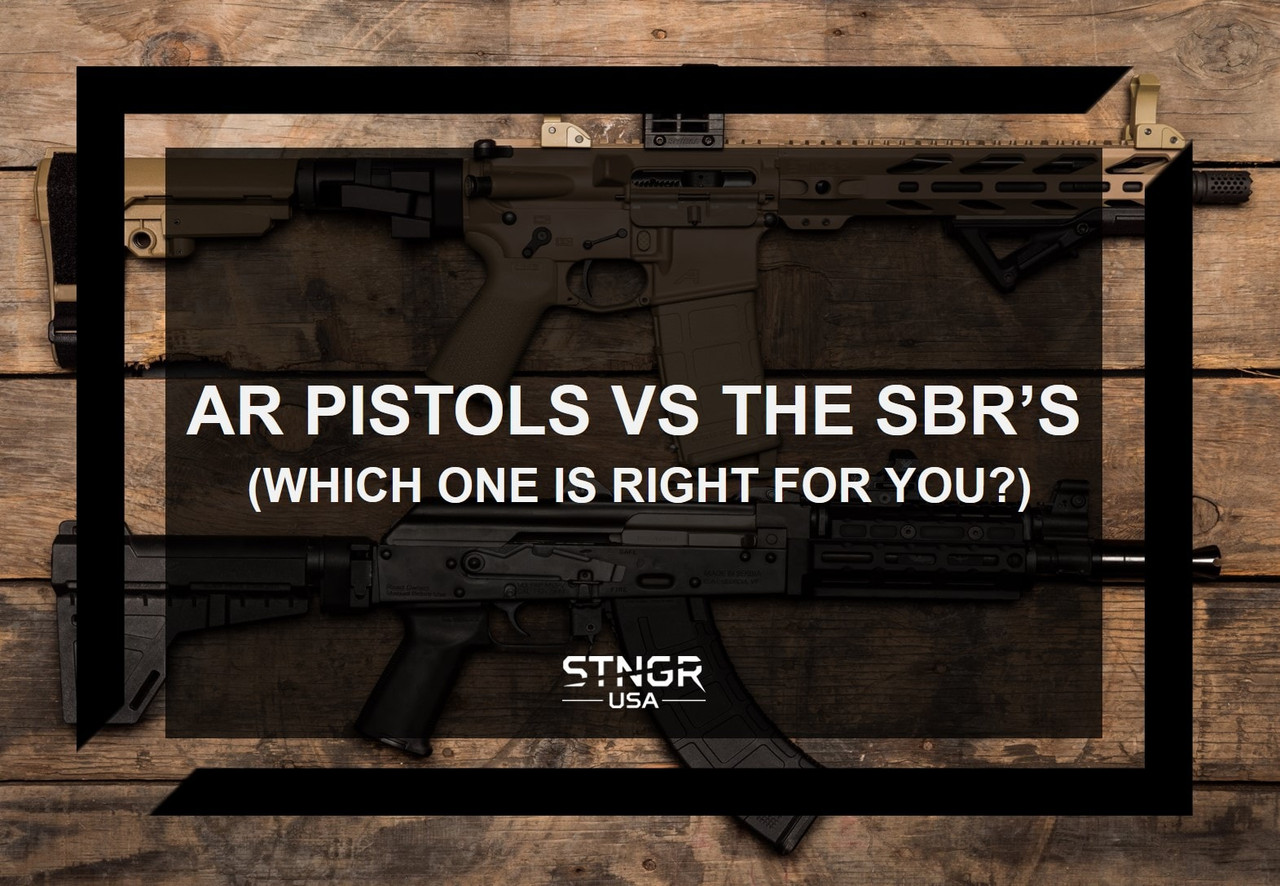AR Pistols vs the SBR's
Posted by STNGR USA on Oct 14th 2022
AR Pistols vs the SBRs
Short-barreled rifles and AR pistols are one of the hottest trends in the firearms community right now. In an era where AR fatigue has set in with many shooters, and the ATF seems to be getting increasingly confused on the definitions of their own policies, shooting a rifle caliber from a short-barreled firearm legally is becoming a great option.
Defining the AR Pistol and the SBR:
AR Pistol
The AR pistol is a firearm built on the AR receiver that has barrel shorter than 16 inches and an overall length of 26 inches or less, but instead of a traditional buttstock at the rear there is either a bare buffer tube or an arm brace at the rear of the firearm. The overall length measurement has been a topic of controversy as of late, so we won’t go into depth on how to measure that for the purposes of this article. Another important point in the definition is that the firearm is not to be built with the intention of shouldering it when firing; as of current date it is legal to shoulder the AR pistol as long as you have come to peace with the fact that you are not using the firearm as intended. As long as your AR meets these specifications, it is considered a pistol by the ATF and falls under normal pistol laws; your state’s specific regulations may vary.
Short-Barreled Rifle
The short-barreled rifle is any rifle with a barrel length under 16 inches and/or and overall length of under 26 inches. These firearms are designed with the intention the being shouldered during normal operation. While these are considered an illegal firearm under the National Firearms Act, when you pay a $200 tax to the ATF it becomes legal. If that doesn’t make sense to you, you are correct. The benefit here is that as a registered NFA item, this rifle sill continues to be legal if federal law does not change, where the definitions regarding AR pistols are somewhat subject to the interpretations and changing opinions of bureaucrats.
Similarities
There are several similarities between these two types firearms. Firstly, they look very similar as many modern pistol braces look quite a bit like buttstocks. They are both capable of chambering in multiple calibers, and this allows for customization to fit your specific needs. Both are modular systems that give the shooter the ability to attach any number of accessories such as sights, lasers, lights, grips, muzzle devices, etc. There are some caveats that we will get to later though.
Differences
The most obvious difference is the rear of the firearm. The pistol brace required for AR pistols will have some features that allow for easier single-handed control of the AR platform while the buttstock on the SBR will likely lack those extra features.
Another difference is what types of attachments can be added to the fore end of the firearm. While SBRs have no specific limitation on what type of foregrip can be used, a vertical fore grip is not allowed on an AR pistol. AR pistols can use angle fore grips or hand stops, but the act of adding a vertical fore grip constitutes the transformation from pistol to SBR in the eyes of the ATF.
Another major difference is the laws and regulations that must be followed when building or owning either of these types of firearms. While short-barreled rifles do require a tax stamp and registration with the ATF, once your SBR is approved there are relatively few restrictions on it. Though, your SBR cannot be transported across state lines without ATF approval, and transfers will require extra paperwork and more fees. AR pistols don’t require any ATF intervention at all and can be transferred or moved around the country just as most pistols can; of course there are varying state laws that must be consulted prior to taking your AR pistol into a new state to ensure your are in compliance.
Which is right for you?
One of the biggest motivators for choosing an AR pistol is that there is no need to pay for the tax stamp and registration. This makes getting an AR pistol easier, faster, and cheaper than choosing an SBR. One point of concern with an AR pistol is the fact that regulations, and the interpretation of current regulations, are subject to change by bureaucrats and not necessarily elected law makers. While the recent past has been quite favorable towards the growth of the AR pistol market, there is no guarantee that this will continue in the future.
The definition of an SBR has remained essentially unchanged for the past 80 years. This does build some confidence in the fact that your rifle will not become illegal overnight with the stroke of a pen. There are those among us that do have serious reservations about registering any firearm with the government, and this is a requirement for any SBR. There is also the extra cost and waiting period associated with a tax stamp that may discourage many from this option.
Final Thoughts
While there are many similarities between the SBR and the AR pistol, there are some differences that should be considered when making your selection. Either way, it’s very difficult to have a frown on your face when shooting either of these options and we recommend you try at least one of the two. Of course there is always the questions we must ask ourselves, why not both?


